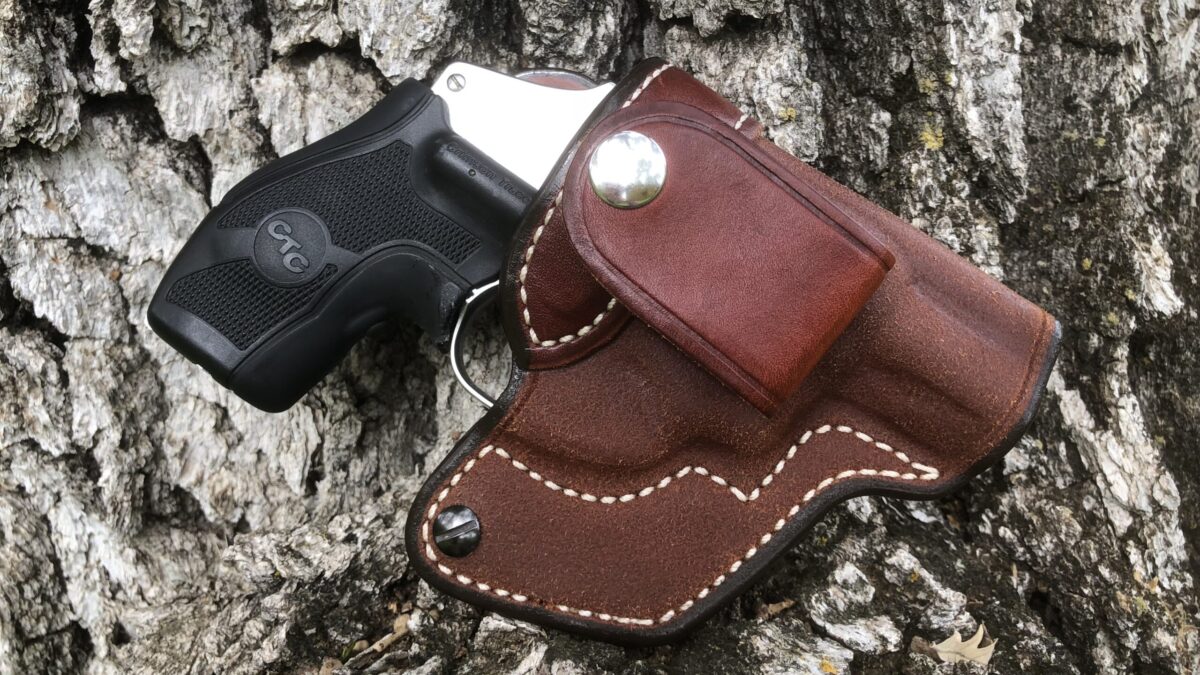We get a lot of holsters to review here at RevolverGuy, and not all of them show up in a post when it’s all said and done. Sometimes the product is no different than one that we’ve already reviewed, and it’s not worth the bandwidth to feature it. Other times, the product needs to go back to the drawing board before it’s ready for prime time.
Once in a while though, there’s a holster which really stands out from the others, and this is one of those times.
The Man Behind Sam Andrews Custom Leather
RevolverGuy SHBond357 contacted me a while back and urged me to get in touch with Sam Andrews, of Andrews Custom Leather, and talk to him about the fine leather holsters that he crafts by hand. It was Bond’s experience that Andrews made some of the best gunleather around, and he was eager to connect RevolverGuy with this craftsman.
I knew of Mr. Andrews, courtesy of Al Gore’s internet, but had never spoken with him or seen any of his products firsthand. I was impressed by what I saw though, and SHBond357’s nudge was just the excuse I needed to reach out.
My first conversation with Mr. Andrews was a bright reminder that some of the best people in the world call the gun industry their home. If you were to believe the media and the gun-haters (but I repeat myself) out there, you’d walk away thinking that “gun guys” are all a bunch of dark-hearted, anti-social misfits, but it’s been my lifetime experience that “the gun culture” is quite the opposite, and overwhelmingly consists of really great folks. Instead of the malignant, ignorant, and racist caricatures of the gun control lobby’s feverish dreams, I’ve found that “gun people” are kind, welcoming, sharing, intelligent, patriotic, and good-natured people. Instead of brooding on what divides us, it’s been my experience that gun people are a lot more interested in focusing on what unites us.
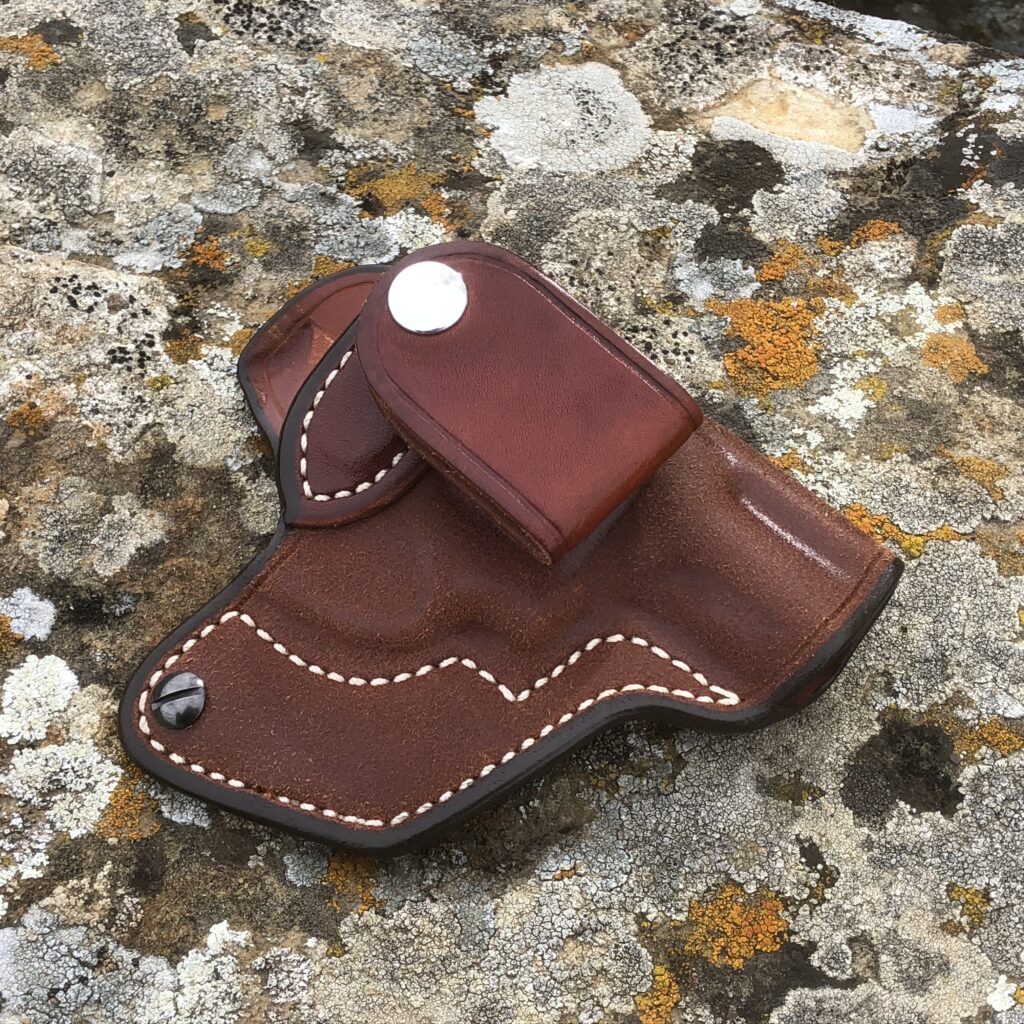
From the start, I found Mr. Andrews to be a shining example of this. He was friendly, helpful, and a perfect gentleman. I was acutely aware of the fact that my phone call had probably interrupted him from his work in the shop, and the time he spent with me was time that couldn’t be spent doing the work that kept the refrigerator full and the lights on, but he was both friendly and gracious, and didn’t try to rush me off the phone. He was eager to answer my questions and educate me on not only his products, but the art of leather work itself. I got the distinct feeling that this was the norm for him, and if I’d been a regular customer instead of a writer, he would have spent just as much time with me to ensure that I selected the right holster for my carry needs.
We concluded the enjoyable conversation with his promise to send me a T&E copy of his MacDaniel II Crossdraw holster for my S&W Centennial, and when it came, I was not disappointed.
Versatility
The MacDaniel II Crossdraw is an inside-the-waistband (IWB) holster that’s designed to be carried forward of the hip bones, or the “3 – 9 Line” for those of us who like to use the familiar clock reference. Although the “Crossdraw” moniker indicates this holster is reserved for that method of carry, it’s eminently suitable for my preferred appendix carry (AIWB) position as well. Additionally, the MacDaniel II Crossdraw can be easily reconfigured to allow its use as a behind-the-hip, IWB holster (in the fashion of the regular, MacDaniel II model, for those so inclined.
The key to this flexibility is the holster’s belt loop system. In normal use, the MacDaniel II Crossdraw’s single belt loop is mounted in the center position, right over the top center of the gun’s recoil shield. In this location, the loop ably supports the weight of the gun and keeps the holster riding in the desired position and orientation for a crossdraw or appendix draw.
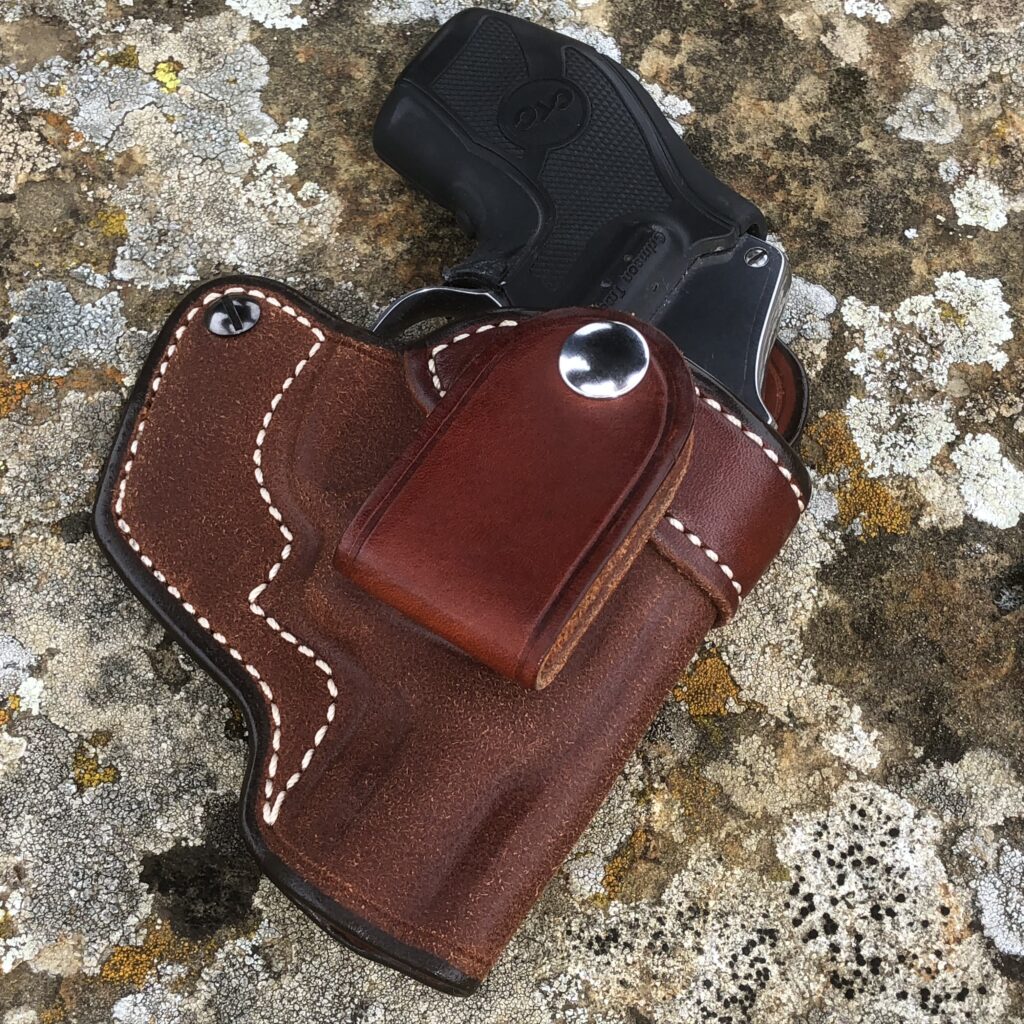
In fact, I was quite amazed at how balanced this holster was, after several disappointing experiences with other holsters that used a single loop or hook to support the gun. In those other rigs, the holster would pivot around the single loop (which was often mounted forward of the center axis) and the grip would rotate around the belt line at odd and unpredictable angles that interfered with grip access and fouled the draw. Yet, on the MacDaniel II, the holster remained rigidly fixed in the proper orientation and didn’t rotate at all. I attribute this to the following:
1. Mounting the loop in the proper location, at the center of gravity, to discourage asymmetries that would lead to rotational movement;
2. Using a very wide (1.5”) loop, mounted with a locking washer, to prevent rotation and ensure stability on the belt;
3. The friction provided by the rough side out leather, and;
4. The influence of the trailing “wing,” which will be discussed in greater detail, later.
The center-mounted loop on the holster can also be removed and reinstalled in a different position on the trailing edge of the holster, to convert the holster to a regular, MacDaniel II model, which is designed to serve as a behind-the-hip IWB holster. While some users may find the center-mounted loop to be compatible with behind-the-hip carry, mounting the loop on the trailing edge of the holster’s “wing” potentially makes for a “cleaner” draw, because it tucks it out of the way, out of the drawing hand’s path. In the crossdraw or AIWB position, the hand naturally approaches the grip from the rear of the gun, but in behind-the-hip carry, the hand approaches the gun from the front, where the extra thickness of the loop could cause interference as the hand bumps into it on the way to the pistol’s grip.
The aft mounting hole is plugged with a screw on the Crossdraw version of the MacDaniel II, but the loop and plug are easily traded for each other to affect the conversion described above. In my particular case, I never swapped the parts because I was only interested in carrying the holster in the AIWB position, but the capability is there for those who want to use it.
The “Torque Plate”
A unique feature of the MacDaniel II is the metal-reinforced wing on the trailing edge of the holster that Andrews calls the “Torque Plate.”
The leather extension on the trailing edge of this IWB holster is reminiscent of a Paris Theodore influence. Theodore, the colorful personality behind the now-defunct Seventrees operation, was probably the first to popularize a wider skirt around the pistol pouch of an IWB holster, to help in stabilizing the gun. The tension provided by the belt on this wider skirt would supplement the effect of the belt loop, and help to keep the heavy package in place.
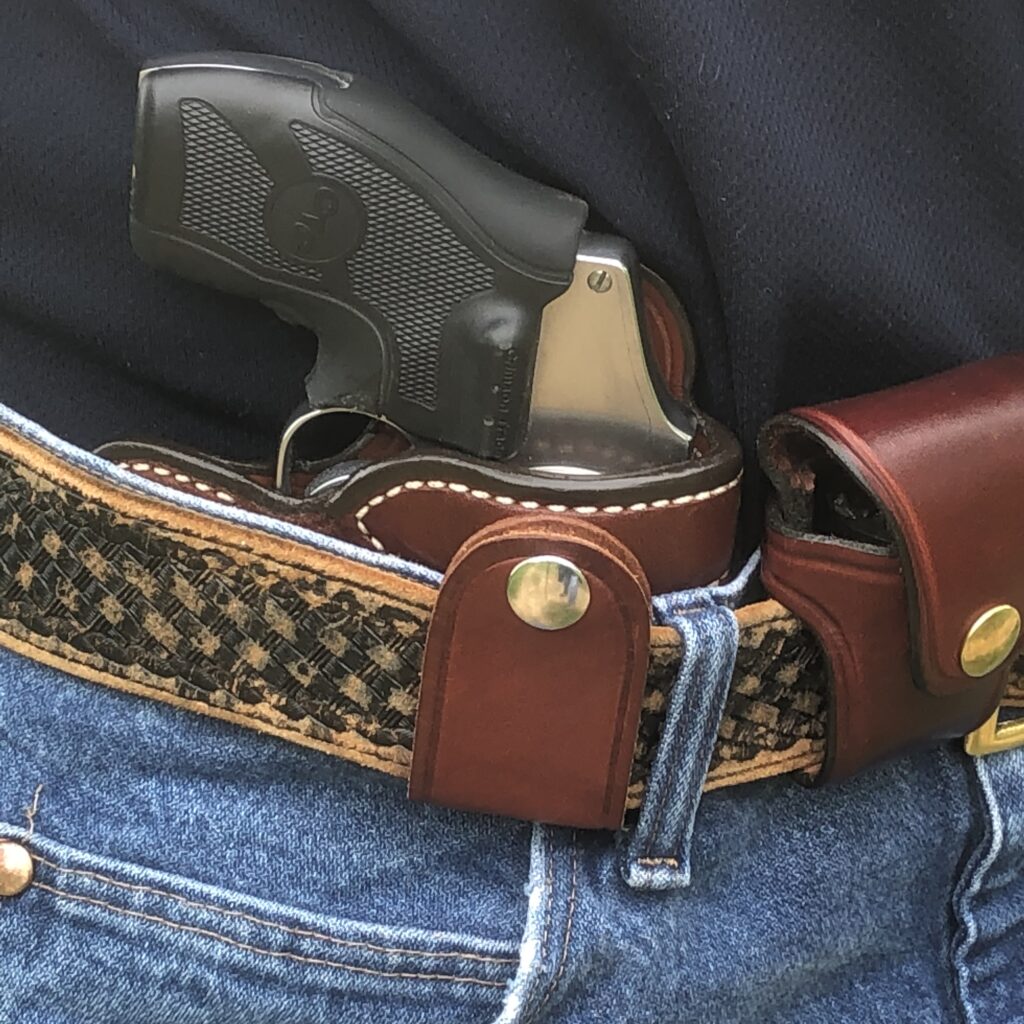
Andrews takes this concept one step further by sandwiching a strip of metal between the layers of leather on the trailing edge of the MacDaniel II holster. This metal-reinforced, leather “wing” on the aft edge adds a great deal of stability to the holster, by providing a wide surface for belt tension to hold things in place. Additionally, the belt “pulls” on this wing, rotating the butt of the weapon into the wearer’s body for greater concealment when the package is worn forward of the hips.
I found that the Torque Plate was an essential part of the holster’s stability on the belt, and also found that it helped to reduce printing. It’s a clever design element in this holster and I think it demonstrates how Andrews has a deep understanding of how all the different parts of the design work together to create the desired effect.
The Usual, Perfectly Executed
The MacDaniel II Crossdraw incorporates all the features we’ve come to expect from a good holster design. The trigger guard area is properly covered for safety, yet also sufficiently relieved to allow the shooter to establish a proper firing grip on the gun, when it’s in the holster.
The holster mouth is reinforced with a metal band, covered by a heavy, 12-ounce leather strap to ensure that it doesn’t collapse when the weapon is drawn from the holster. A sight tunnel allows the proper clearance to prevent drag and keep your sight picture clear of the leather fuzzies that would disrupt it.
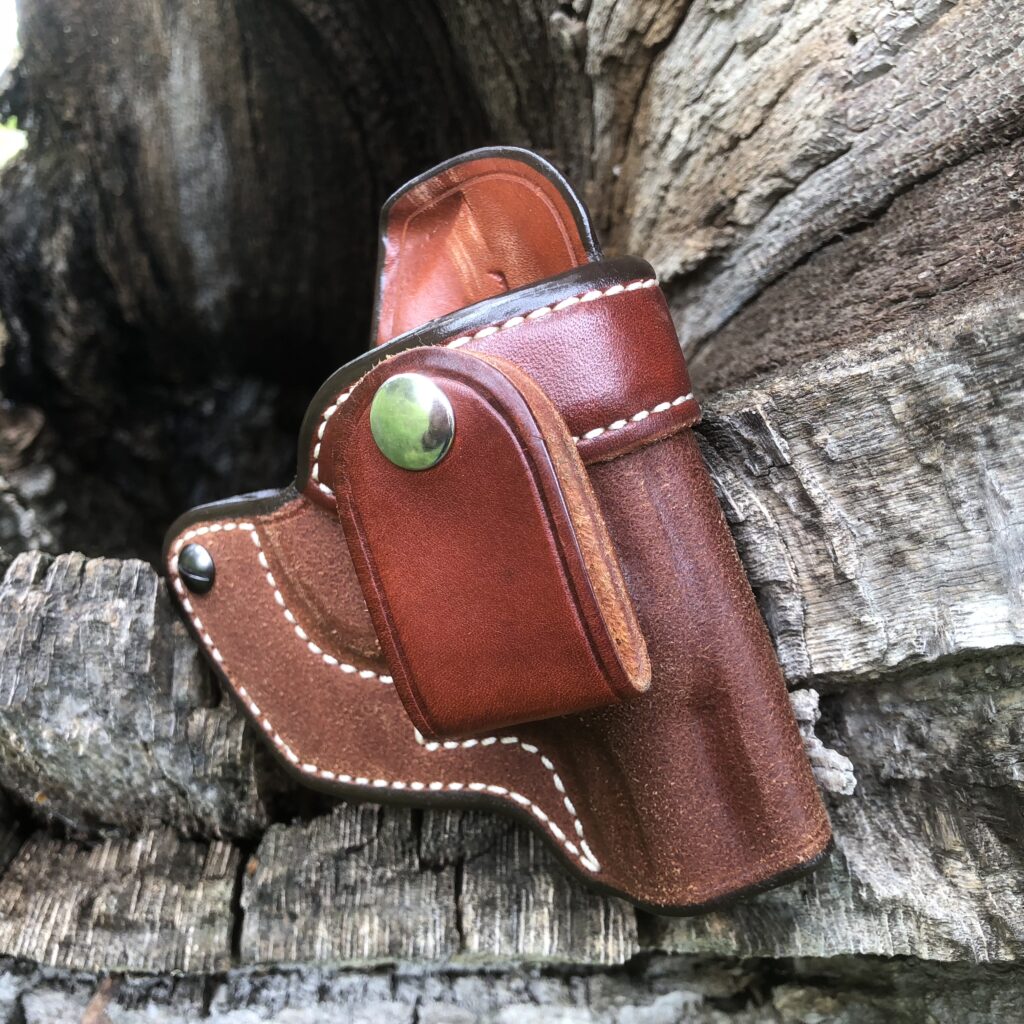
A raised body shield on the rear panel protects the gun from exposure to your acidic skin, and your skin from irritation, without interfering with a proper grip.
Artwork in Leather
As a true custom holster maker, Andrews pours a lot of effort into each of the products that comes from his workbench. No detail, no matter how small, is overlooked in the process.
The mass-production outfits like DeSantis, Galco, Aker, or Safariland-Bianchi all make excellent, handsome and robust products, and we’ve been proud to feature many of them here in these pages, but they’re playing a different game than a custom maker like Andrews. The Big Guy’s operations are tailored to large scale production, and they can’t afford to labor over the fine details like Andrews can.
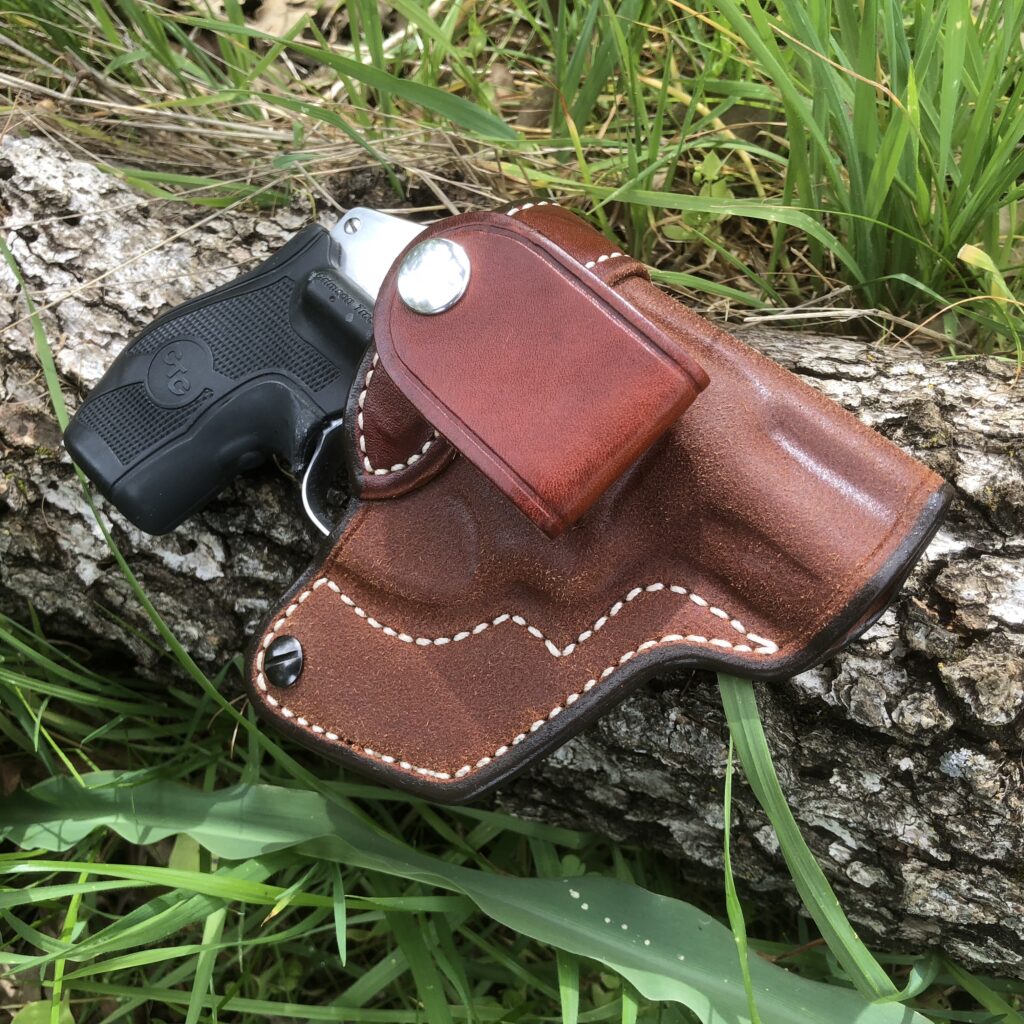
You’ll see that attention to detail when you take a close look at a holster like this MacDaniel II Crossdraw. The perimeter of the leather is attractively grooved, and the edges are all properly slicked to give a smooth and rounded surface that will provide comfort for the wearer. Inside edges are properly beveled to prevent a square corner from “grabbing” the gun on the draw. The bonded nylon (impervious to solvents, oils, and UV breakdown) stitching is even and precisely placed.
The pouch is carefully boned by hand–using wood tools and elbow grease–to improve fit and weapon retention. Andrews notes that “revolvers are the worst” to bone, because they have “lots of curves and irregular shapes” to mold, as compared to the straight and blocky lines of an autopistol like the Glock, and I can only imagine how much effort it took to shape this pouch for my curvy Centennial.
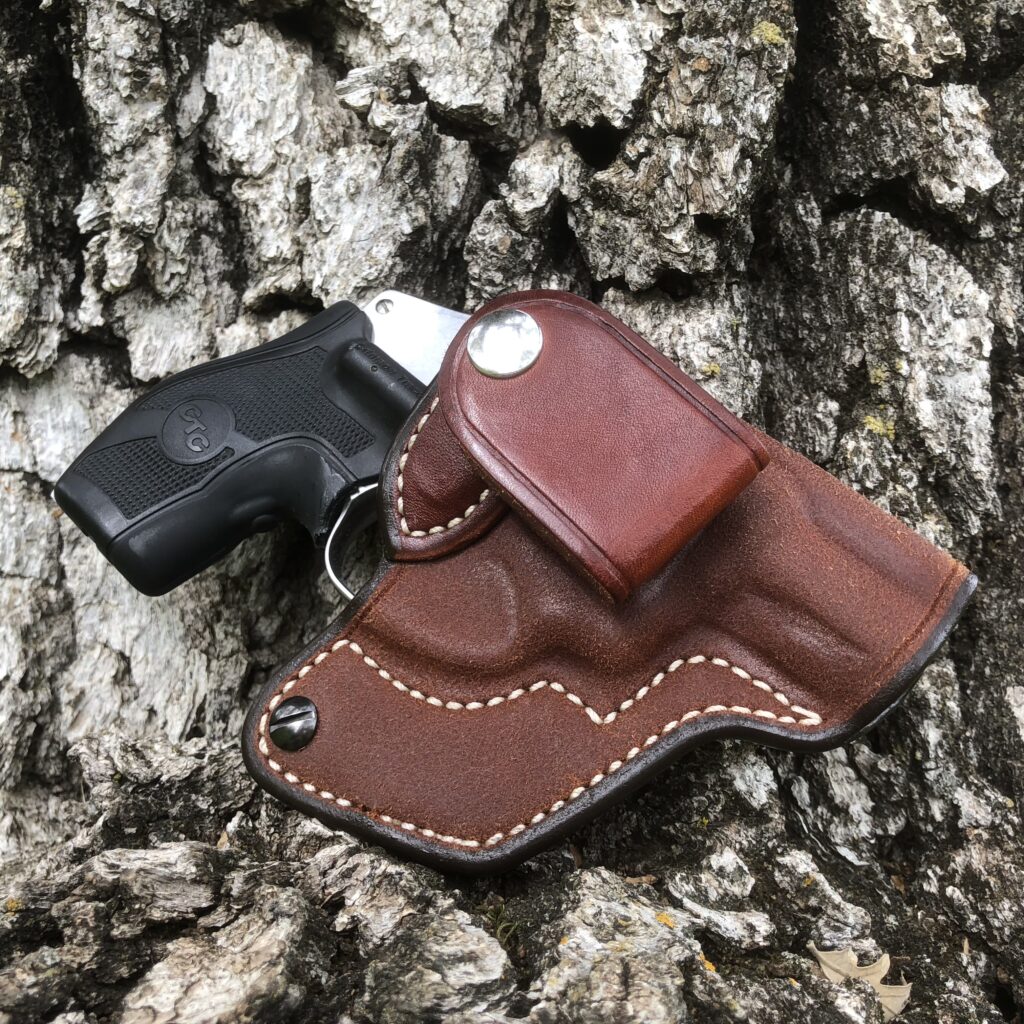
The attractive, high-quality leather used by Andrews (8-ounce weight, for the body, and 12-ounce weight for the mouth band) is beautifully finished. The edges are coated with a flexible enamel that Andrews custom mixes for the job, and the hide is treated with neatsfoot oil to protect it from moisture and bring out the natural color. After the oil dries, the holster is then airbrushed with an acrylic resolene to further waterproof and seal the leather, and give it a soft shine.
Wearing the MacDaniel II Crossdraw
The holster looks fantastic, but the real beauty is in how it performs.
As mentioned, I expected the holster to rotate around the single loop, as I’d previously experienced with other holster designs, but the MacDaniel II was rock steady and presented the gun at the same angle every time. I appreciated the toothed washer on the belt loop, which allowed me to set the desired cant and lock it down with a screw. Initially, I carried the holster in a straight vertical fashion, but over time I added about 10-15 degrees of rearward cant to enhance the draw angle, without crowding the grip area with the top edge of the belt.
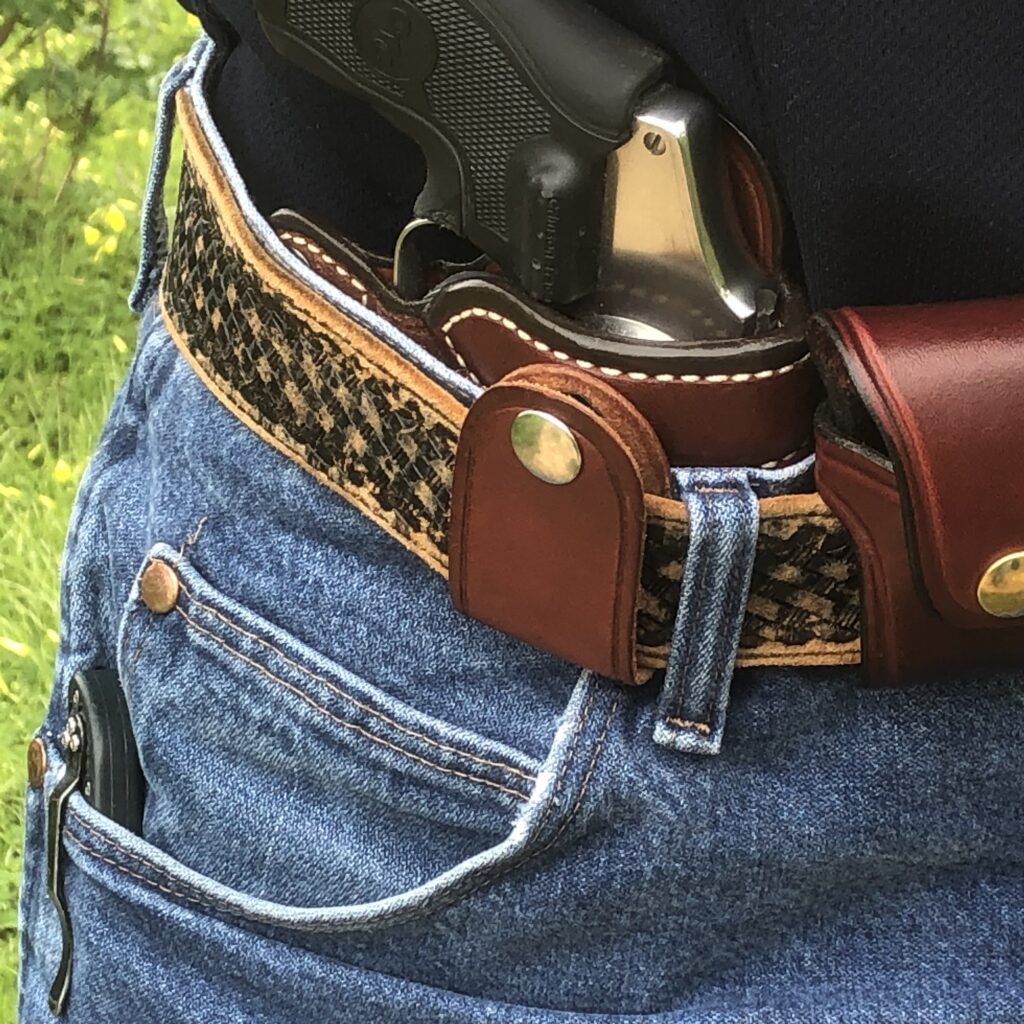
The MacDaniel II Crossdraw was an incredibly comfortable rig to wear, regardless of my activity. For the last 3 months, I’ve been wearing it from the moment I put my pants on in the morning, until the time I took them off at night, and I have yet to experience any discomfort with it. I’ve hiked with it, driven with it, limbed trees with it, sat all day long at the computer with it, and changed a tire with it, and the holster has always comfortably stayed where it’s supposed to and retained my gun.
I should note that a highly experienced, valued and trusted RevolverGuy that I loaned this holster to had a different experience with the MacDaniel than I did. We are built differently, and he favors an IWB holster that sits deeper behind the belt, because guns that ride higher tend to be uncomfortable for him. He recognized the build quality of the MacDaniel, but it just didn’t work for him, either in front of the hip or behind it.
That happens sometimes, and it’s not a criticism of the MacDaniel as much as it is a commentary on the highly individual nature of holster selection. My perfect solution might be a nightmare for you, and vice versa. For example, I can’t wear an IWB holster in the traditional, behind-the-hip position, without being in agony an hour later, but I can wear an AIWB holster all day long without a hint of discomfort. Yet, one of my buddies thinks AIWB holsters were built as torture devices, and swears by his 4 O’ Clock-carried IWB.
There’s a reason every serious gun guy has that “box-o-holsters” in the garage, to bear witness to the journey of experimentation that all of us go through until we find “the one true way,” yes?
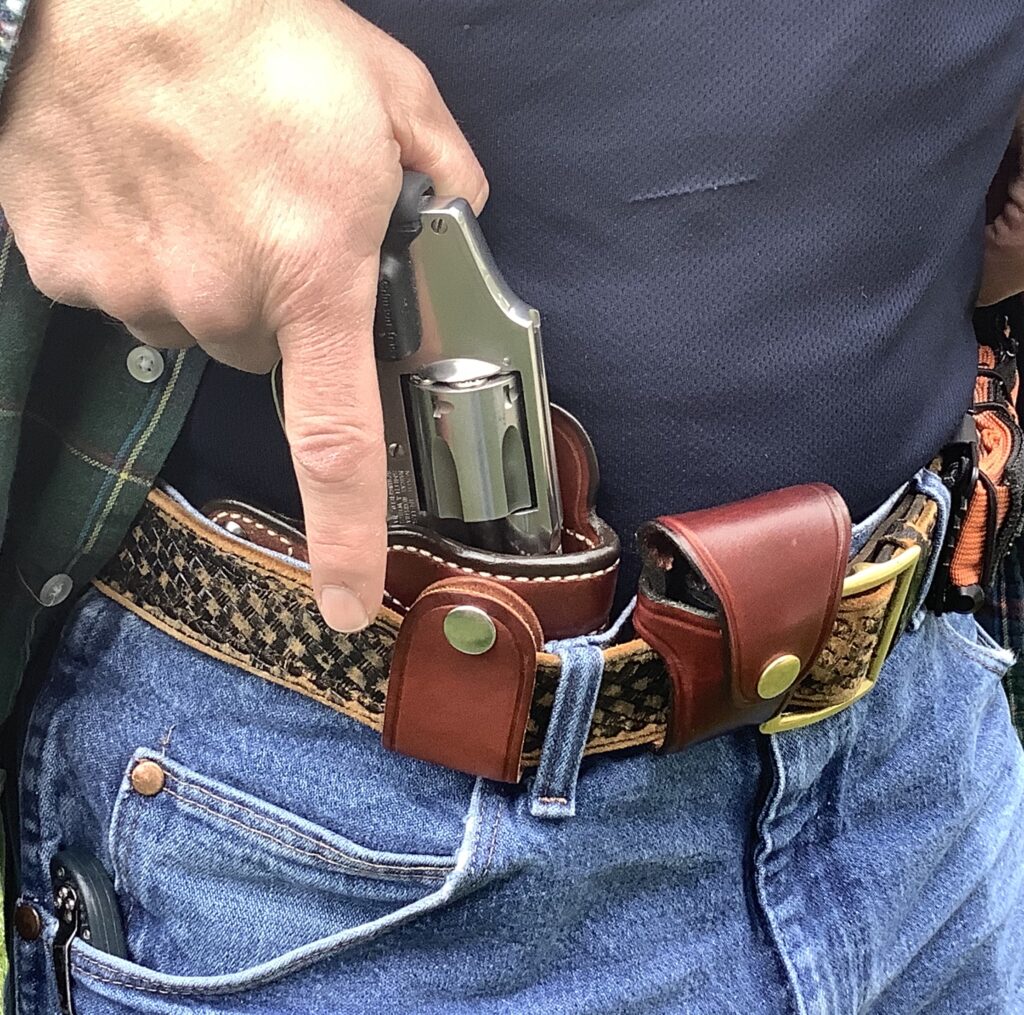
Returning to the MacDaniel II Crossdraw, the directional snap on the loop has made it easy to don and doff, and the package has integrated nicely with the Don Hume Pack Six loader pouch that I’ve worn just ahead of it on my belt. They actually look like a matched pair, save for the fact that my Hume pouch has brass hardware, instead of nickel.
Drawing from the MacDaniel II Crossdraw is always smooth and positive—at least when I do my part–and holstering (h/t Red Nichols) is easy and safe, courtesy of the reinforced mouth and dense leather body that keep the pouch open after the gun comes out.
Came By It Honestly
Andrews notes that “it took a lot of experimentation, and a lot of mistakes” to learn how to design and build leather like this. In the vein of other holster makers like Jewett, Bianchi, Shoemaker, and Rogers, Andrews got his start in the leather business by working it as a side job, while he worked full time as a police officer.
In the 1980s, Concord (CA) Police Officer Sam Andrews had ready access to a group of gun-carrying “guinea pigs” to help him test his designs and perfect his art. Andrews gleefully notes that his fellow officers were, “truthful and profane with their feedback, never leaving any doubt about what worked and what didn’t,” and they helped him hone the skills that allowed him to quit policing and focus on holster making.
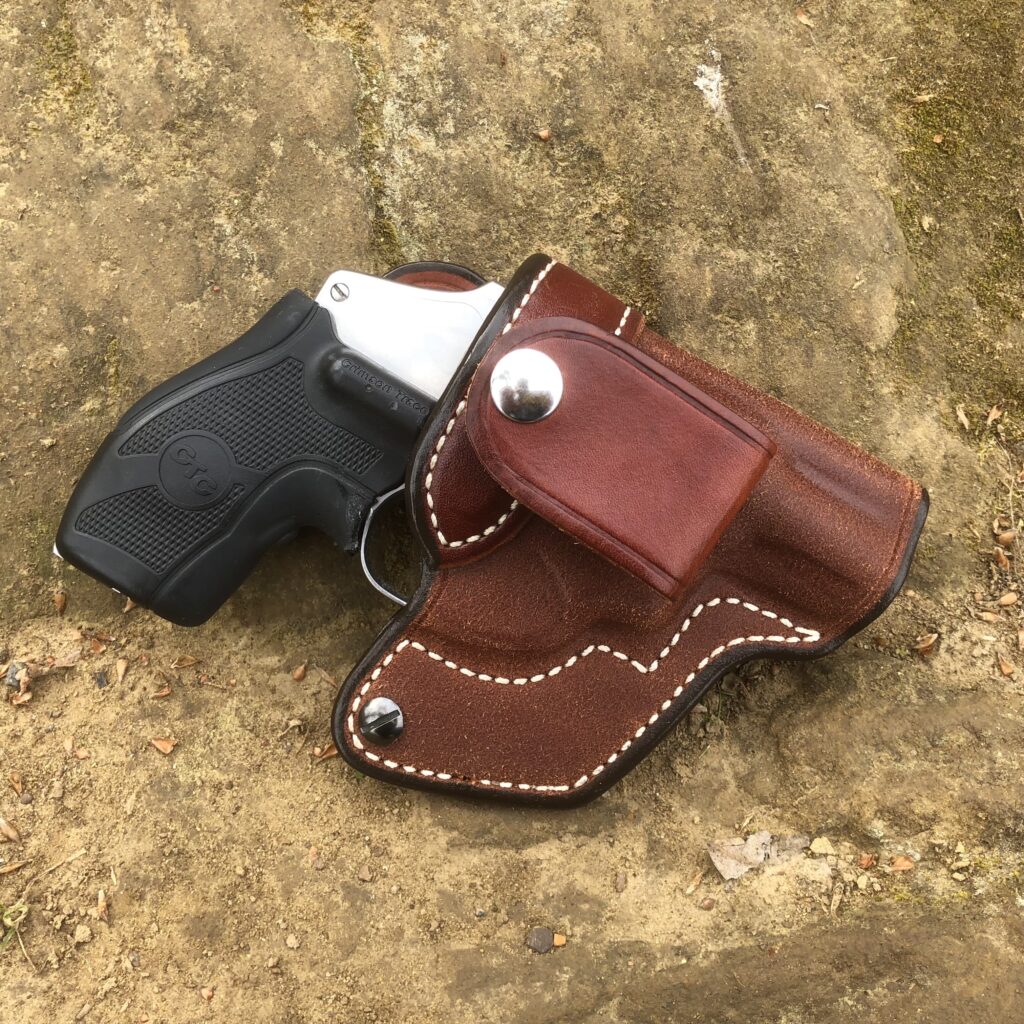
We owe those guys a debt of gratitude for helping Andrews along the way. He’s a master of his art, and I’d highly encourage the members of our RevolverGuy family to look him up if you’re in need of a top quality, leather holster, belt, or accessory for daily use.
If you do, tell him that RevolverGuy sent you!

